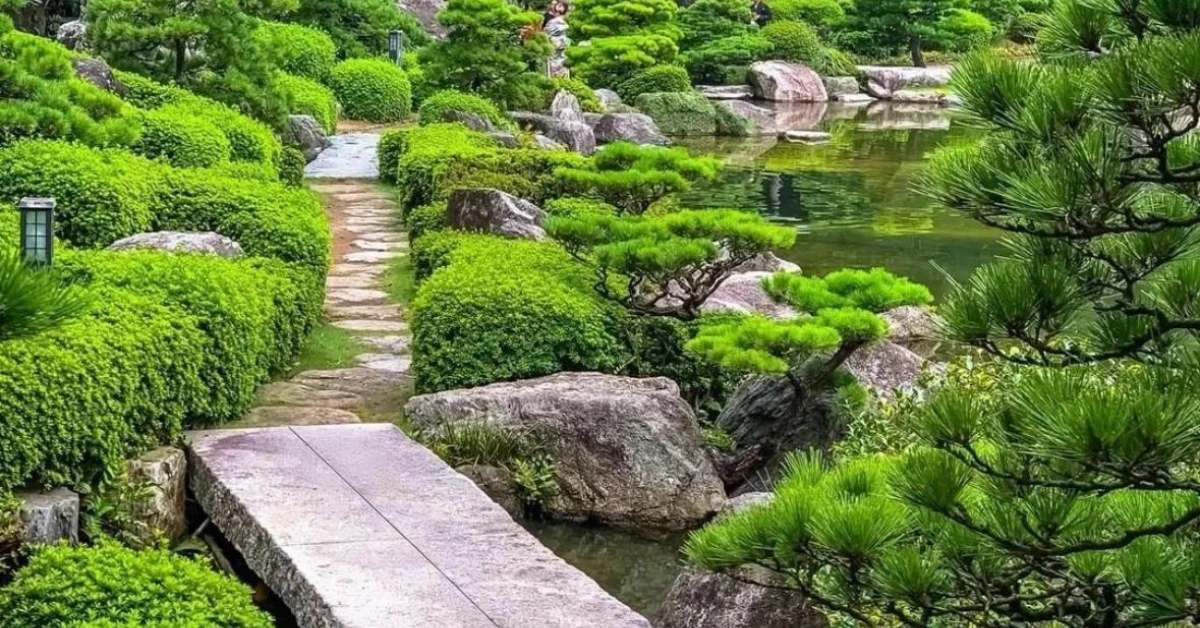To create a peaceful and calming outdoor space, many homeowners are turning to the concept of a Zen meditation garden. These gardens are designed to promote relaxation, reflection, and mindfulness through the use of natural elements and minimalist design. By incorporating features such as rocks, water, and plants, a Zen garden can provide a serene retreat from the stresses of daily life.
In this article, you are going to know the Basics of Zen Meditation Garden and what Elements are typically included.
Pros: ✅ Advanced Noise Cancellation Technology ✅ 40-Hour Playtime ✅Pressure-Free Comfort
Cons: 🚫 Restricted App Settings
Zen Meditation Garden Basics
As someone who has been practicing Zen meditation for a few years now, I have come to appreciate the importance of having a dedicated space for meditation. One of the best ways to create a peaceful and calming environment is through the use of a Zen meditation garden. In this section, I will cover the basics of Zen meditation gardens, including the importance of these gardens and the key elements that make up a Zen garden.
Importance of Zen Meditation Garden

Zen meditation gardens are designed to provide a peaceful and calming environment that helps to facilitate meditation and mindfulness. These gardens are typically simple and uncluttered, with a focus on natural elements such as rocks, sand, and water. The purpose of a Zen meditation garden is to create a space that is conducive to relaxation, contemplation, and inner peace.
One of the key benefits of a Zen meditation garden is that it provides a designated space for meditation. This can be especially helpful for those who struggle to find a quiet and peaceful place to meditate in their home or office. Having a dedicated meditation space can help to create a sense of ritual and routine, which can be helpful in establishing a regular meditation practice.
Elements of Zen Meditation Garden

There are several key elements that make up a Zen meditation garden. These include:
Rocks
Rocks are an essential element of a Zen garden. They are typically arranged in a way that is aesthetically pleasing and helps to create a sense of balance and harmony.
Sand or gravel
Sand or gravel is often used to create a smooth and uniform surface in a Zen garden. This surface is then raked in a pattern that is meant to represent water or waves.
Water
Water is another important element in a Zen garden. It can be represented by a small pond or fountain, or even just a simple bowl of water.
Plants
Plants are often used sparingly in Zen gardens, with a focus on simple and unobtrusive plants such as moss or bamboo.
Bridges and paths
Bridges and paths can be used to create a sense of movement and flow in a Zen garden. They can be made from a variety of materials, including wood, stone, or gravel.
Zen meditation gardens are a great way to create a peaceful and calming environment that is conducive to meditation and mindfulness. By incorporating key elements such as rocks, sand, water, plants, and bridges, you can create a space that is both beautiful and functional.
Pro Tip
Creating Your Own Zen Meditation Garden

Creating a Zen meditation garden can be a rewarding experience that promotes relaxation and mindfulness. Here are some key considerations to keep in mind when designing your own Zen garden.
Selecting the Right Location
The location of your Zen garden is crucial to creating a peaceful and tranquil space. Look for an area that is quiet and away from distractions. Consider the amount of sunlight and shade in the area, as well as the type of soil and drainage. If you plan to meditate in your garden, make sure it is easily accessible and has enough space for comfortable seating.
Choosing Garden Elements
When it comes to selecting garden elements for your Zen garden, keep it simple and minimalistic. Consider incorporating elements that promote relaxation, such as water features, rocks, and sand. You may also want to include plants that have a calming effect, such as lavender, chamomile, and jasmine.
Zen Garden Elements
Water Features
Water features such as fountains, ponds, and waterfalls can add a calming and soothing element to your Zen garden.
Rocks
Incorporating rocks of different sizes and shapes can add a natural and grounding element to your garden.
Sand
Sand can be used to create patterns or raked designs, promoting relaxation and mindfulness.
Plants
Choose plants that are low-maintenance and have a calming effect, such as lavender, chamomile, and jasmine.
Designing the Zen Garden

When designing your Zen garden, consider the principles of Zen Buddhism, such as simplicity, balance, and harmony. Keep the design minimalistic and avoid clutter. Use symmetry and repetition to create balance and harmony in your garden.
Here are some tips for designing your Zen garden:
- Use straight lines and geometric shapes to create a sense of order and structure.
- Use contrasting colors and textures to create visual interest.
- Incorporate a focal point, such as a statue or boulder, to draw the eye and create a sense of balance.
- Use lighting to create a peaceful and calming atmosphere in the evenings.
- By following these tips, you can create a Zen meditation garden that promotes relaxation, mindfulness, and inner peace.
Maintaining Your Zen Meditation Garden

As with any garden, maintaining your Zen meditation garden is essential to ensure its longevity and continued beauty. There are two main types of maintenance for your garden: daily maintenance and seasonal care.
Daily Maintenance
Daily maintenance involves small tasks that keep your garden looking its best. These tasks include:
Raking the Sand: Raking the sand in your Zen garden can be a meditative practice in itself. It helps to create a peaceful and calming atmosphere. Rake the sand in a pattern that you find soothing, such as wavy lines or concentric circles.
Removing Debris: Debris, such as leaves or twigs, can quickly accumulate in your garden. Remove any debris you find to keep your garden looking neat and tidy.
Watering Plants: If you have plants in your Zen garden, make sure to water them regularly. Check the soil for moisture and water as needed.
Seasonal Care
Seasonal care involves larger tasks that are done on a less frequent basis. These tasks include:
Pruning Plants: Prune any plants in your garden that have overgrown or become unruly. This will help to keep your garden looking neat and tidy.
Replacing Plants: If any plants in your garden have died or become damaged, replace them as needed. Choose plants that are well-suited to your climate and the amount of sunlight your garden receives.
Refilling Sand: Over time, the sand in your Zen garden may become compacted or displaced. Refill the sand as needed to keep your garden looking its best.
By following these simple maintenance tips, you can ensure that your Zen meditation garden remains a peaceful and calming space for years to come.
What to Meditate Upon in a Zen Garden

- The Act of Raking:
- One of the simplest yet profound meditations in a Zen garden is the act of raking the gravel or sand. As you draw the rake through the grains, envision the waves of life, the ebb, and flow of your experiences.
- Let the rhythmic motion of raking become a moving meditation, grounding you in the present and helping you release the concerns of the past and future.
- The Stillness of Stones:
- Choose a rock within the garden, one that resonates with you. Gaze upon it and consider the centuries it has stood, witnessing the passage of time.
- Meditate on the steadfastness of this rock, allowing it to remind you of your own inner strength and resilience. In moments of doubt or challenge, return to this rock in your mind, drawing from its unyielding presence.
- Moss and Growth:
- Sit quietly beside the moss or plants in the garden. Observe their quiet persistence and the gentle way they spread and thrive.
- Contemplate the idea of growth, not as a hurried pursuit, but as a patient and steady progression. Allow this contemplation to inspire your own journey of self-improvement and spiritual growth.
- The Empty Spaces:
- Zen gardens are known for their abundant empty spaces. These spaces represent the importance of silence, stillness, and non-attachment in meditation.
- As you meditate, focus on the emptiness, letting it encourage you to let go of clutter and distractions, both in your surroundings and in your mind. Embrace the freedom that comes with emptiness.
A Zen Meditation Garden offers numerous benefits to both physical and mental health. Regular meditation in a Zen Meditation Garden can improve overall well-being, reduce stress and anxiety levels, and improve focus and concentration.
FAQ
What is a Zen meditation garden, and how does it facilitate meditation?
A Zen meditation garden is a serene and harmonious outdoor space designed to support meditation and mindfulness practices. It typically features carefully arranged elements like rocks, gravel, sand, and minimalist greenery. Its purpose is to create a tranquil and contemplative environment conducive to meditation and reflection.
Do I need a large outdoor space to create a Zen meditation garden, or can it be adapted to smaller spaces?
Zen meditation gardens can be adapted to various space constraints. While larger gardens offer more design flexibility, smaller spaces can feature mini Zen gardens with potted plants, rocks, and sand. The key is to create a space that promotes tranquility and encourages mindfulness, regardless of its size.
What are the main elements of a Zen meditation garden, and what do they symbolize?
The main elements of a Zen meditation garden typically include rocks, gravel or sand, moss, and minimalist plantings. Rocks may symbolize islands or mountains, gravel/sand represents water or ripples, while moss and plants offer a sense of life and balance. These elements collectively create a harmonious and balanced environment for meditation.
How can I use a Zen meditation garden in my meditation practice?
A Zen meditation garden can be used as an outdoor meditation space. Find a comfortable spot to sit or kneel, and use the garden as your focal point. You can meditate on the symbolism of the elements, practice mindfulness as you observe the garden, or simply enjoy the tranquility it provides to deepen your meditation practice.
After exploring the serene depths of Zen Meditation Garden, we’d love to hear your thoughts and experiences. Share your insights with us in the comments below!







I am designing a large garden area in western India. One of the “rooms” (Joe Eck) I will create is a zen meditation garden. I love your ideas and suggestions. Can keep you posted once I get started early next year.
Thank you 🙂 Good luck and please keep us updated.